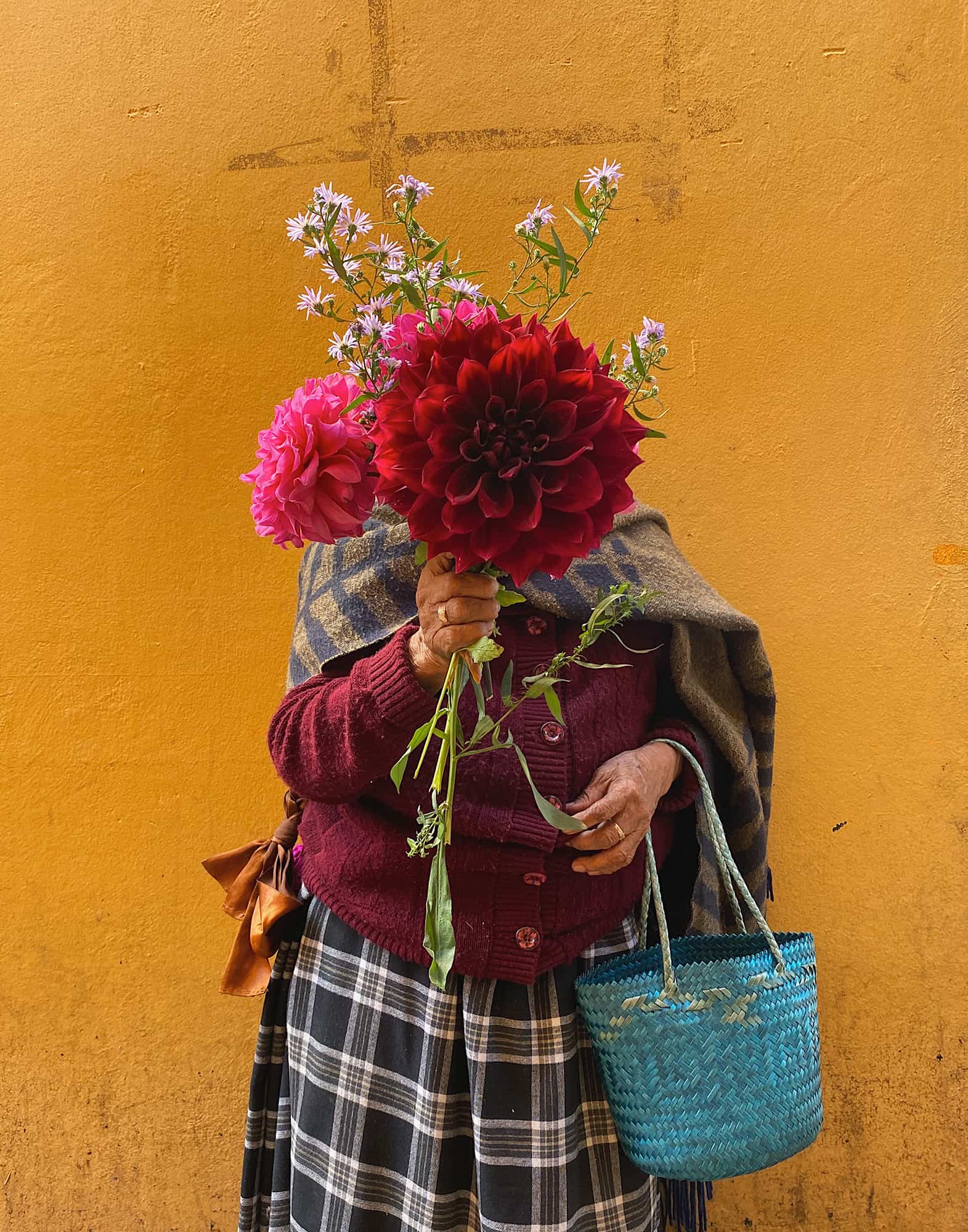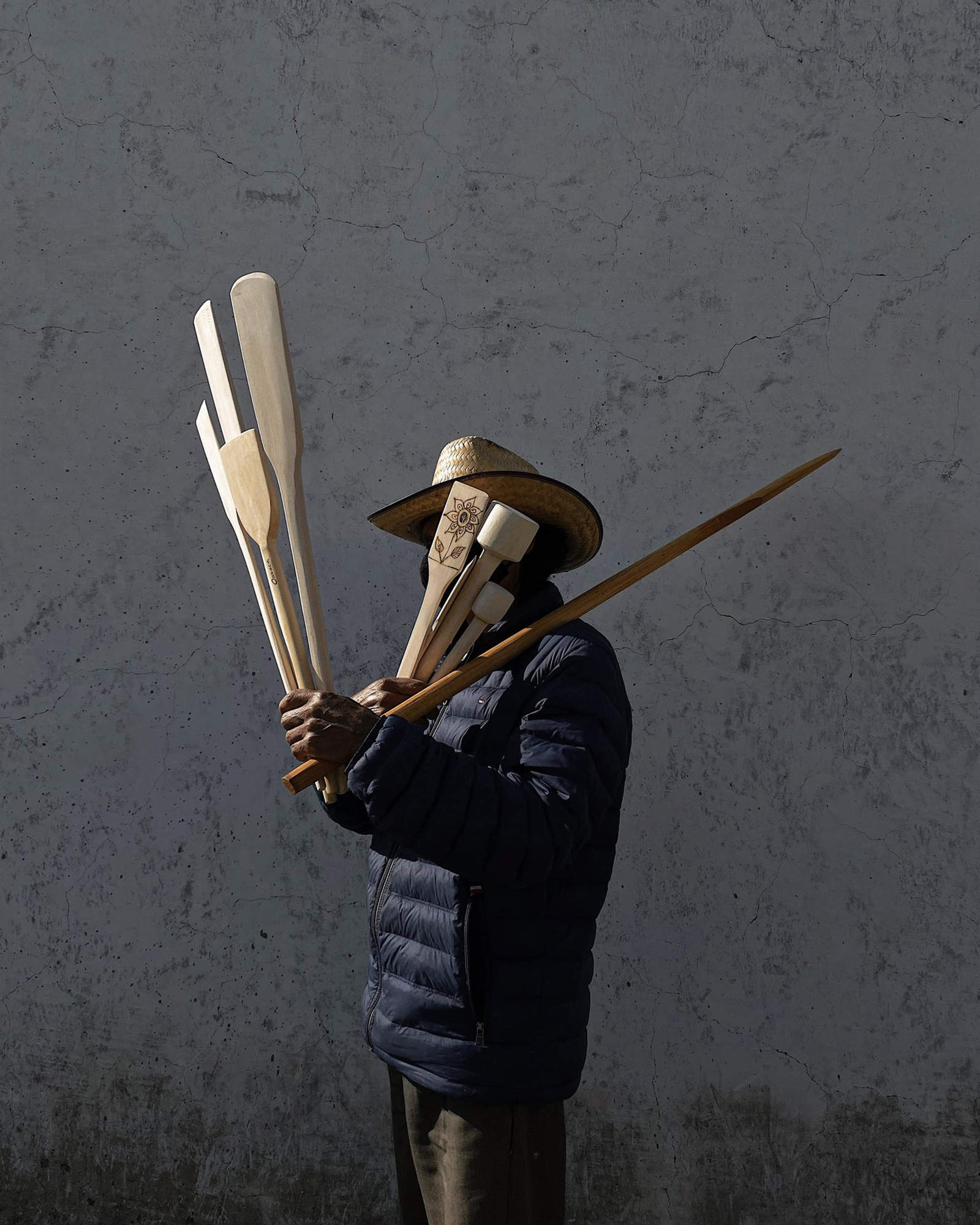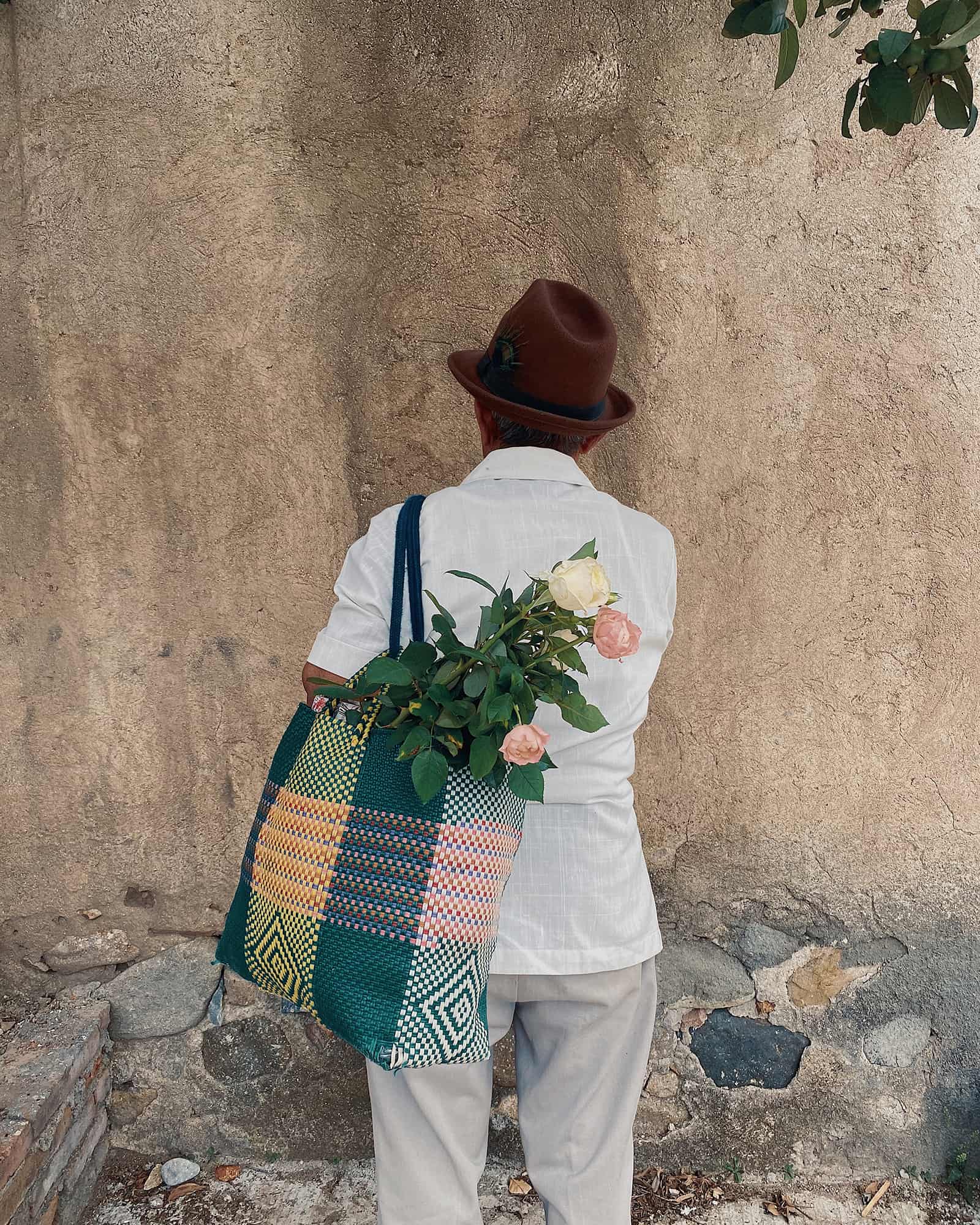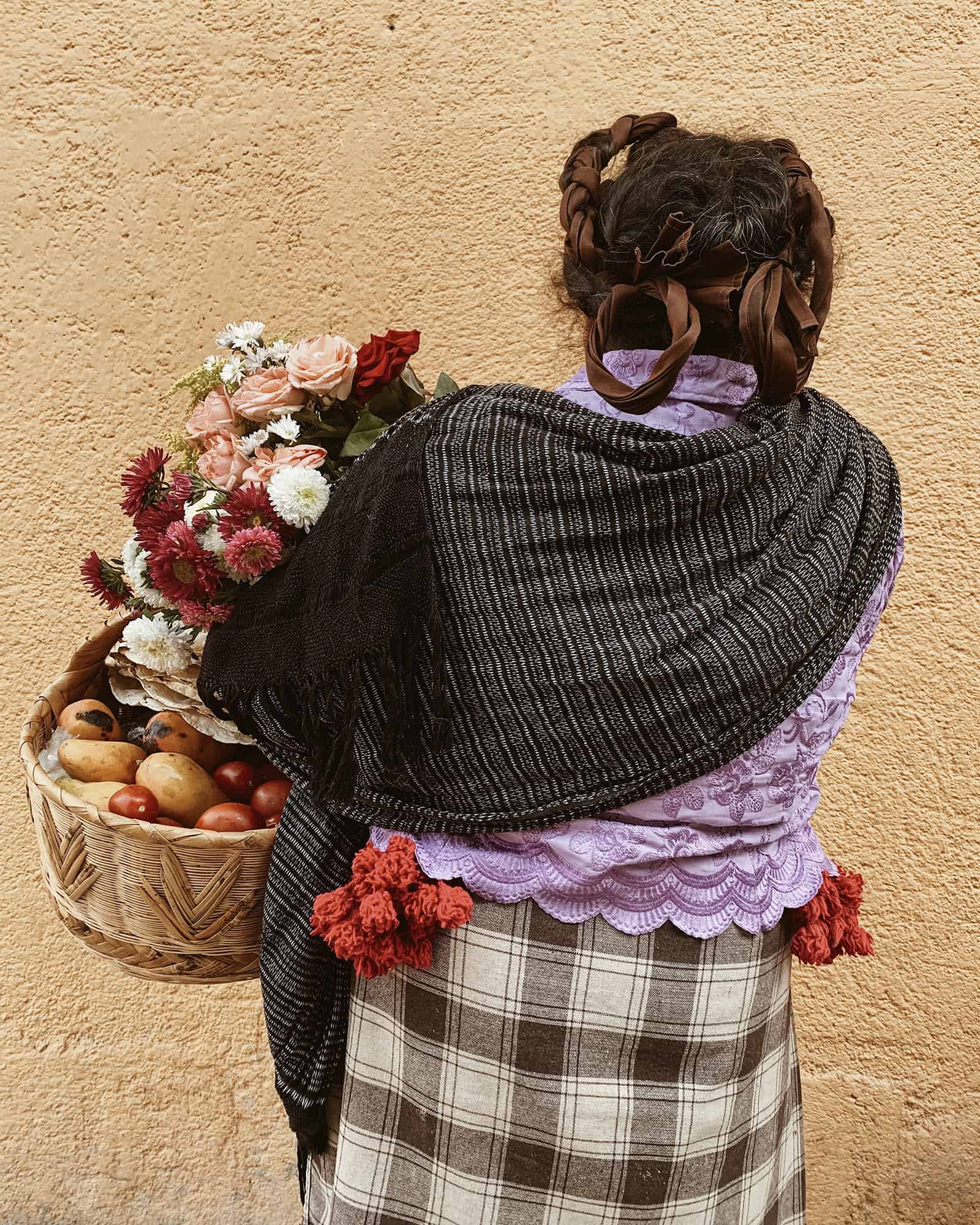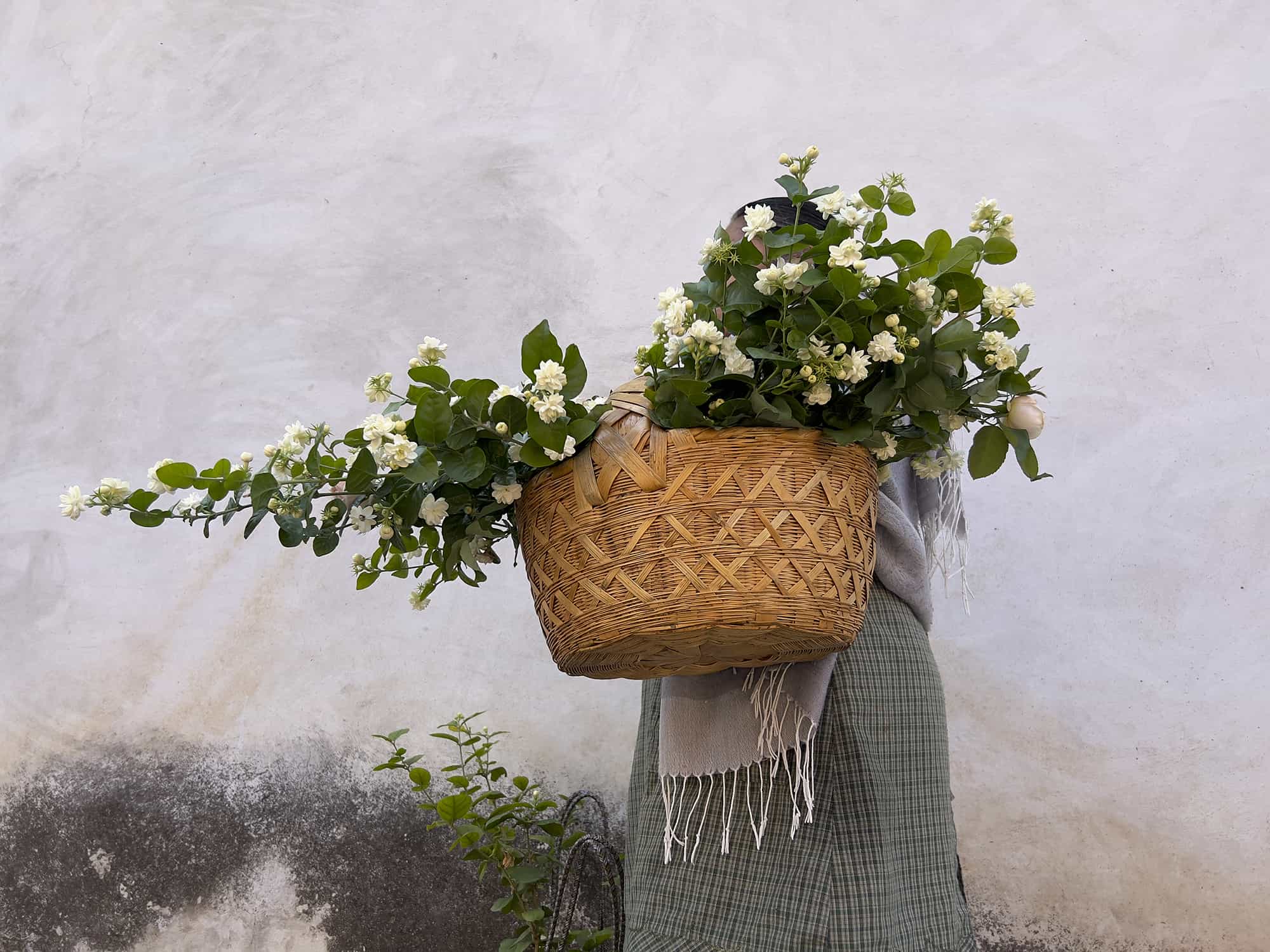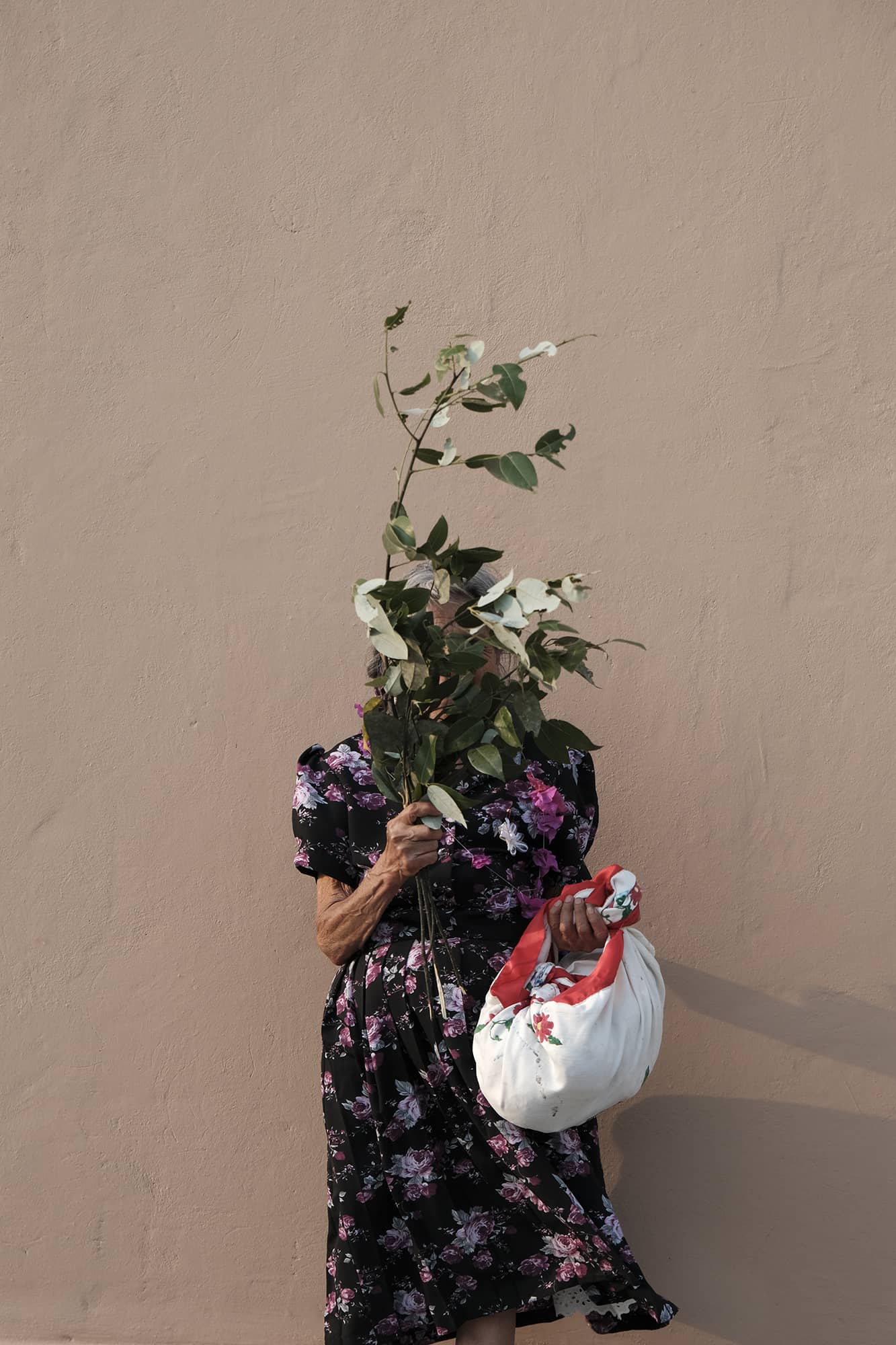Listening with our eyes
Luvia Lazo’s Photography
Photography is the art of memory but also an aesthetic language that speaks of forgetting and loss. In the work of Luvia Lazo—Zapotec artist born in Teotitlán del Valle, east of Oaxaca City—photography becomes an art of nostalgia and mourning. Her portraits emerge from the necessary rearrangement of the world after death, but they record spaces full of vitality, meanings, colors, textures, and flowers.
Luvia Lazo practices the art of multidisciplinary living: she is a photographer and belongs to a family of butchers. Together with her parents, she sells meat on Sundays at her community’s market; at the same time, she has been creating images for fifteen years. Her photographic project, Kanitlow, arises from the space she has inhabited since childhood: the market. There, Luvia Lazo has poured her gaze and deep listening towards the grandmothers and grandfathers, older people who pass through the market, sell, buy, barter, walk, talk, exist. Wandering among traditional and contemporary elements, they form a community in the midst of skeins of thread, plants, chocolateatole, food, baskets, vegetables, seeds, wooden utensils, bread, flowers, textures, rebozos, patterns, walls, and colors. This series of photos, however, has a particularity: the people portrayed all appear with their backs turned, or their faces hidden.
The word kanitlow, as the artist explains, is used in Zapotec to name “something or someone that begins to disappear, when a close friend stops being close, when someone stops visiting frequently, when things transform or when someone begins to lose their vision.” This photographic series emerged after the death of Luvia’s great-grandfather and the inevitable mourning that accompanied it. This painful context draws a link to the concept of kanitlow, which could be literally translated as “faces become lost.”
The basic ingredients of the aesthetic experience are set to work in the series with precision, emerging from the everyday: color, shape, lines, pattern. Luvia Lazo documents the extraordinary beauty of the habitual and minuscule: embroidery, the texture on a shirt, the color of a wall, the weave of a basket, the arrangement of hair, the shimmering of an earring, the weave of wrinkles, the particular shape of certain flowers, the fall of fabric, the gesture of an arm holding something.
These portraits of older people are unusual, because contrary to the documentary tradition in photography that approaches old age as synonymous with the end of life and the journey towards death, in Luvia’s work, those portrayed are active presences: they are here, they inhabit public space, participate in the world, contribute to their community, they produce, negotiate, sell, walk, talk, live. They are present, visible and at the center, even if we cannot see their faces. We had the pleasure of speaking with Luvia Lazo about this series, where faces may be absent but where everything else that can inhabit a portrait is revealed. These were the words she shared with us.
The gaze of mourning
The first photo I took without faces—which I now connect to this work—was of my grandmother. My relationship with her was a bit distant, detached. From time to time, she would come to the house to say hello to my mom, and that day she was visiting.
My mom (who always wears dresses with flowers, earrings with flowers, aprons with flowers, her room is full of flowers) had bought a hibiscus that was in bloom that day, and she asked me to take a picture of her with her hibiscus. I got the camera to take her picture: her with her hibiscus. When my grandmother was leaving, I don’t know why, I asked her, “Can I take a picture of you?” I had never taken pictures of her before, because I didn’t feel close to her. She looked at me and agreed. “But with your back turned,” I told her, “you don’t have to see me,” and she stood right next to my house, and I took that picture, at that moment.
That was long before this series. I didn’t even remember that photo, which came out of the fear of not knowing what to do with the relationship I had with her. I didn’t want to invade her. Then, looking through my archives, I found the photo, and I couldn’t believe it was identical to the photos I’m taking now. That was the first photo I took with a back turned. It’s why I’m including it, even though the picture was never intended for this series.
I lived with my great-grandparents. They were already old, and I was aware “they would die soon or someday,” I thought. I was very shy, and photography became a way of being, feeling, expressing. It was my language, a way to navigate my space and my great-grandparents’ home. I also learned visual language—or communicating without words—because my great-grandmother had a stroke and didn’t speak for seven years. But we talked all the time, even without speaking. We had a way of communicating through images.
When my great-grandfather died, it was a complicated process. I understood grief. Yes, I felt my heart was broken. For me, my grandfather Domingo is the root of this photographic series. We spent the last month of his life together. I listened to him a lot, and we talked a lot. I think older people want to talk, and I can sit and listen to them for hours, just as I did with my grandfather. Once he was gone, I would have liked to stay and listen to him for a bit longer.
He walked a lot, and I started walking a lot, with the camera. Whenever I walked, there was someone who reminded me of him. That’s how this series began. I was thinking about my grandfather. I have many pictures of him, but almost all of them are of his hands, his unbuttoned shirt, his eye, his ear. When you know someone so well, you see those little things; when you lose them, you remember those details.
In my grandfather’s case, I remember precisely how he wore his hat: a little bit on the side, not too much. For me, all those little things were what was really important to observe in him. Then, when I started looking at other elderly people, I would see what I saw in him. I would see the clothes or a little chain, and when I started talking to them, it was the blouse that her daughter sent her from the United States or the chain that his son had given him when he graduated. All those elements, put together, were speaking and saying something well beyond their faces. I didn’t need to see their eyes or faces to understand them. I wanted to show the truly ordinary.
There is a photo of a man with wooden cooking utensils. One day I was in the market, and suddenly I saw a blue jacket, like my grandfather’s. I ran after him. When I caught up with him, I said, “Oh, sorry, I mistook you for someone else,” and we sat down to talk.
That was the first Sunday, and I saw him many more Sundays. I would go to talk to him, because I could see his hands and how he played with his fingers, and they were just like my grandfather’s, just like his. I remember when taking that picture of the utensils, the hand, the silhouette, everything; I took it and began to cry. I knew it was not my grandfather, but when I saw the photo, I felt that if I removed the wooden spatulas, I would see him. It wasn’t him; it was the process of searching for him.
I no longer cry when I take pictures. There came a time when it didn’t hurt anymore, and I stopped crying. But that led me to deep conversations, especially with women. Getting close to them, talking and speaking Zapotec, showed me on another level who they were and what they knew. It had nothing to do with their eyes. Some would ask, “aren’t you going to take a photo of me from the front?” One lady asked me to take one, “for when I die so that they can put it on my coffin.” That was very intense for me.
I like to sit and listen to them, I like to go and see them, go to their spaces, go and greet them, listen to their stories. Also, I feel that it’s like tricking life. Some women have told me things I never thought they would say to me. When I listen to them, I find that although they are not from my time, we have many things in common. I look at these people who have lived, achieved, made mistakes, and I think this human part of everyone is universal.
Looking at what is ours
When I talk about my photography, I talk about myself, because they are not separate in any way. I grew up in the market, and every Saturday and Sunday we went to sell. I am part of it, and the people I meet there have known me since I was a little girl. During high school and college, I never called myself Zapotec, and I didn’t want to speak Zapotec with others out of shame. But then, back in town, they would say to me, “How come you are embarrassed?” I felt out of place, neither here nor there. Over time I have learned to embrace who I am, this is part of me, and I love it.
It took me years to name it: yes, I take pictures; and yes, I sell in the market in Teotitlán. I name that I am Zapotec, and I am a butcher. Because that, for me, is the basis of how I move in that space, because I grew up in it. I know the people and what it’s like to eat at the stand, go to another, exchange, bargain, sell, get dirty, pack up, everything. At the end of the day, it’s all part of me, and I need to embrace it to navigate that space naturally. This is the market, and this is where I see things.
I think about how to clear the canvas for my photos because what I want to show is the person. There, in that moment. Sometimes I’m asked what my photographic process is, and I don’t have one. But I’m always thinking about image, image, image.
I’m also interested in what is “ours,” what we consider our own. When I left Teotitlán, I realized everything is connected: the rituals, the forms, the memory, everything. How did this Pinotepa blouse become Teotitlán del Valle’s traditional garment? How is it that a Guatemalan blouse is part of it? How is it that this fabric, which comes from China or London, is incorporated into our attire? How did it become part of our tradition? I was starting to have, instead of answers, questions.
So when I see all these images together, I see Emiliano with his linen suit, but also the man carrying yarn with his Levis. I see a lady with the typical outfit with the enredo, and another wearing pants, which the first one was never allowed to wear. I also see a lady with a traditional blouse with flowers and a North Face jacket that her son gave her. Yes, we are Zapotec, yes, but everything is transforming, and everything is changing. It is happening, and it needs to be named. That’s how I began disentangling myself and observing other things, by not paying attention to the face.
The many faces of flowers
I had always seen flowers as something merely decorative. But I remember when I started to observe them. Before, I was just looking, and suddenly I began to observe in the market that one flower was used for this, and another was used for that. One day we were making cocoa flower necklaces for the saints, and I asked my mom why we use that flower. “Because it is tradition,” she told me. And why not another? That’s when I started to pay attention. By reading each flower and learning its meaning, one sees what is happening in that season of the year, what is going on in the market, or in that situation.
Some flowers are just for the cemetery. Some are for church, and others are for saints. Some are for godparents at a wedding, or for children, others are only for women. I started to observe all that, and I found it incredible. It was cyclical, the Flor de Niño is only used at Christmas, and on January 15th, we only have poinsettias, because we celebrate San Antonio, and the market turns red. On the Day of the Dead, we have flor de muerto, and the whole market smells of them. During Holy Week, the saints have necklaces of frangipanis, to accompany the Stations of the Cross.
Also, each plant has a symbolic meaning—for example, pennyroyal. The photo I have of my grandmother with pennyroyal was because she was coming back from accompanying the godparents blessing for a christening. That plant is given to the godparents, a respected family that cares and guides. You don’t give pennyroyal to just anyone.
For me, to continue making images, to keep seeing and asking myself questions, has helped me to ask myself personal things. Sometimes I portray the smells that remind me of living in my great-grandparents’ house. When I am not in Teotitlán, I depict Teotitlán, I look for it in other places. I look for things that resemble it. Usually, what I portray is emotion. But mostly, I photograph memories in my mind. It’s like an album. The image is my language, and I like what it makes me feel. That’s my rule, to feel. And that which I feel, I want to keep it honest and sincere. Not showing people’s faces, I want to keep it that way.
A version of this article appears in print, in Issue 2 of Álula Magazine, with the headline: “Listening with our eyes, Luvia Lazo’s Photography”

